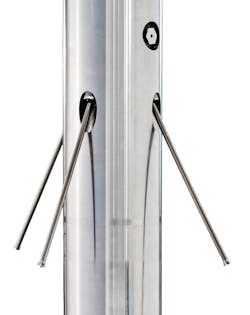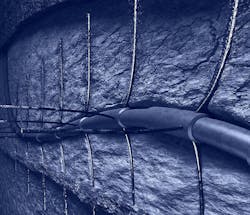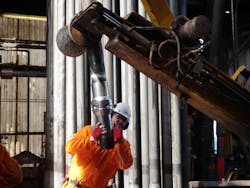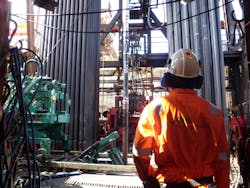Multilateral stimulation techniques improve reservoir penetration
Well stimulation techniques offer operators the opportunity to increase well productivity. Conventional stimulation typically entails hydraulic fracturing, explosives or acidization, but over the past decade, Stavanger-based Fishbones has developed an alternate solution. The company’s oilfield engineers discovered that by connecting the well and the reservoir through an open-hole liner completion, the reservoir could be vertically connected throughout a long well in one short pumping operation.
This new way of connecting the reservoir – known as Multilateral Stimulation Technology (MST) – delivers numerous benefits. These include accelerated production, increased accuracy for pin pointing sweet-spots and bypassing flow barriers, and a heightened flow, achieved by penetrating layers and faults and increasing the effective wellbore radius. Two variations of the system are available: Multilateral Stimulation Jetting Technology (MJST) and Multilateral Drilling Stimulation Technology (MDST). Both are safer, cleaner, and more efficient than traditional techniques.
First jetting tests
With the MJST, the liner string is run in as normal into the open hole, with as many subs as are needed for the well spaced out at even intervals to be deployed at depth. Through pressure differentials across the liner, small diameter tubes (needles) jet out simultaneously to penetrate the reservoir. High-pressure fluid jets away the formation ahead of the needles through a combination of erosion and acid chemical dissolution. At full extension, achievable penetration is typically 12 m (40 ft), creating tangible stimulation effects with immediate results. The number of laterals deployed can be tweaked in relation to a project’s needs. The process can be used with acid for the jetting of carbonates or with non-reactive fluids for other formations.
First trials of the jetting system took place in 2009, with the simulations based on data from a horizontal producing well in BP’s Valhall field in the southern Norwegian North Sea that had originally been completed as a propped fractured well. The simulations modeled a highly porous, very weak chalk reservoir, with hundreds of small level 5 laterals drilled simultaneously into the formation immediately around the main wellbore. Tests included laboratory experiments that simulated the needles’ deployment inside a hollow cylinder core plug with flooding under in-situ stresses. These were followed by yard trials where the needles were tested on chalk blocks.
The qualification program confirmed numerous qualities, including the ability of the system to jet a 12-m (39-ft) long lateral with a 5-10 mm diameter, and the potential for the acid needle jetting system to produce in a challenging chalk environment without the loss of production. It also demonstrated that the resulting production rates would be on a par with those achieved using existing technologies. Final full-scale qualification tests followed in a chalk quarry in Belgium in 2012. Several MJST systems were installed in drilled vertical holes, confirming the feasibility of simultaneous full extension of the needles, the needle trajectories, and the operational sequences.
Initial pilot
The first pilot installation in a horizontal well took place in 2014 in the Austin Chalk carbonate reservoir onshore Texas. It was part of a program managed by the Joint Chalk Research (JCR) group, comprising BP, Shell, ConocoPhillips, the Danish North Sea Fund, Dong, Eni, Hess, Maersk, Statoil, and Total. In this area the Austin Chalk is a tight limestone formation with porosity of 5% and 0.5 mD permeability. During planning, the team reviewed the well geology to establish appropriate stimulation points and depths for placement of open-hole anchors. They also examined core samples from a representative well to determine the optimum rate of penetration and acid volume, established as 15% HCl acid.
A workover rig installed the MJST system and once in place, the liner hanger and liner top packer were set, and the pumping equipment rigged up to perform the acid pumping operation. The 15% HCl acid was pushed through at a rate of 8 bbl/min. During this process, pressures, flow rates and volumes were monitored and compared with expected values.
The production results confirmed significant stimulation of the well through use of the MJST, with a Productivity Index increase recorded of 30 times previous values. At the time, creating 60 laterals in less than five hours was understood to have been a world record. It was followed by another two pilot installations in 2015 and 2016, both successfully qualifying MJST for offshore use. Since then, the MJST system has been deployed in multiple wells around the world, including offshore deployments in the North Sea and in the Middle East. On average, the technology has doubled production rates.
Technology qualification
The Multilateral Jetting Stimulation Technology was further developed to qualify as a new method in 2015, known as multilateral drilling stimulation technology (MDST). This arose from a joint industry project (JIP) involving three major oil companies with support from the Norwegian Research Council from 2012-2015.
The drilling system can be applied in non-reactive formations or in those that are otherwise unsuitable for jetting. MDST operations are simple and can be completed in just a few hours. The reservoir liner string is run as normal into the open hole. Small diameter needles equipped with turbines powered by fluid circulation are released, along with the drill bits, with the latter drilling out simultaneously to penetrate the reservoir. At full extension, the achievable penetration is typically 10.8 m (35 ft), with tangible stimulation effects and immediate results. The number of laterals deployed can be varied according to the needs of the well, with three laterals drilled from each drilling sub.
The MDST passed through concept validation, lab testing and full-scale quarry and yard tests. During the concept validation phase, basic requirements were calculated for torque, thrust and circulation, with detail designs then developed for the turbines, needles and MDST sub. Successful laboratory testing led to further tests in a sandstone quarry in Belgium, which validated the equipment and confirmed the technique was viable. Selection of this site was based on the sandstone properties which were similar to the properties of the reservoir sandstone of the first planned field installation of the technology. These tests too were successful and were followed by full-scale integrated system yard tests, with oil-based mud. Three cement blocks were positioned around the MDST subs for the needles to drill. The positive outcome test led to the declaration of Technology Readiness Level 4 (TRL4) for the drilling system, which was officially qualified for pilot installation in a well.
Case study 1
A new offshore well was drilled for an international operator in the Middle East where the reservoir consisted of a layered limestone formation. First, the team conducted a reservoir simulation to evaluate the potential production improvement: this step is always performed with both the MDST and MJST systems in order to accurately configure the completion in an existing reservoir simulation or in a specially constructed reservoir simulation model. The simulator can be used for both oil and gas wells, with and without pressure support, and for water injectors.
In this campaign, the simulation showed promising results and, after two months of production from barefoot open hole, the well was completed with an MJST system equipped with 25 Fishbones subs, creating 100 laterals. The initial production rates of ~600 b/d of oil were more than doubled after the MJST installation, and the PI increased by more than four times.
Cast study 2
A new dual-lateral subsea well in the Norwegian Sea was completed with MDST in one of the lateral legs. A total of 144 laterals were drilled from the main bore to increase productivity from the tight sandstone formation. The target reservoir, named Upper Garn, comprised an undeveloped, oil-bearing tight sandstone with intermittent cemented stringers overlaying a developed gas formation.
The MDST installation took place from a semisubmersible drilling rig in July 2015, following drilling of the horizontal lateral section. The 2,000-m (6,562-ft) long, 5.5-in. liner featured 48 MDST subs spaced out at targeted intervals, seven open-hole anchors, one catcher screen and the bullnose shoe with closed-off nozzle, and was deployed trouble-free on drill pipe to 6,546 m (21,476 ft) MD. MDST was the selected stimulation method, because the aim was to increase productivity without the risk of connecting the well with the gas formation beneath. A production log was run two years after the installation in 2017. This showed that the contribution from the main bore, where the MDST was located, doubled the contribution from the side track where the pre-drilled liner was installed.
Case study 3
Aker BP has just performed an installation in an offshore field on the Norwegian continental shelf. The project successfully demonstrated an installation of the MDST technology along a 1,400-m (4,593-ft) horizontal well in a layered sandstone/shale formation with close to 25mD permeability in the sands. The main objective of the MDST was to overcome the poor vertical permeability caused by the shale layers. A key challenge with this project was the requirement for sand control.
The delivered solution included a 5½-in. MDST liner with 20 drilling subs (60 laterals), combined with sand screens that were equipped with check valves. The conditioned oil-based mud was circulated for six hours of lateral drilling. The installation was a first for this kind of application.
Future developments
The Multilateral Stimulation Technology system is constantly under review for further development. During 2018 MJST with solids control underwent qualification testing and was deployed for the first time in a pilot well in the Tor formation of the Valhall field. This was the world’s first simultaneous jetting of 72 laterals with solids control.
Based on the original MJST system, modifications were made to facilitate production from the soft chalk formation, which is prone to plastic deformation and liquefaction under the stresses of production. The original design of single titanium needles was altered to a combination of an aluminum outer needle for the deployment phase, and a titanium-slotted inner needle for the production phase.
A series of functional lab tests followed to ensure pressure integrity of the modified design, and the promising results were extended to functional yard trials, to verify the chance of success in downhole conditions. The goal was to evaluate the productivity of solids control using MJST compared to proppant fracturing and to test the ability of solids control MJST to prevent chalk influx. Productivity of the pilot appears to fall within the trend of proppant fractured producers in the same field.
A JIP is also in progress for the development of an oriented system. This new approach will locate where the target is, with jetting or drilling only taking place in the desired directions relative to the wellbore. The new system will be suitable for use in thin reservoirs with oil-water contact nearby, thereby avoiding the need for jetting into water. •
The author
Eirik Renli has more than 35 years of industry experience, having held various management positions with Baker Hughes, most recently as VP for the Sub Sahara Africa Region, before joining Fishbones as CEO. He holds a Bsc in Petroleum Engineering and a Masters in Management, and is responsible for the development and execution of the company’s growth strategy globally.




